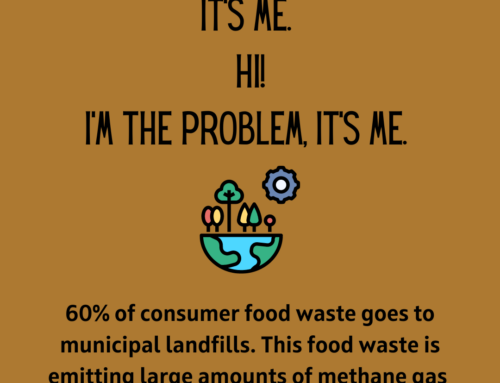Are you a college student, know a college student, or are going to be a college student?
I was recently a guest on SpotOn, a podcast hosted by Dr. Joan Salge Blake from Boston University. The episode was “Cooking For a Few or JUST U”. We chatted about some of the obstacles college students may face when it comes to cooking. Be sure to tune in to the episode. Read on for a free download and tips for getting comfy in the kitchen.
Getting Prepped with Kitchen Basics
Cooking shouldn’t feel like a chore. To get started, you need some decent equipment. It doesn’t have to cost a lot, but there are a few must-haves – a fry pan, a pasta pot, a glass baking dish (oven and microwave safe) a couple of good utensils (I suggest a wooden spoon and silicone turner at a minimum), at least one good knife. If you can, get a baking sheet, a saucepan, a few more utensils and a few different knives too. Check out my Basic Kitchen Tools List here.
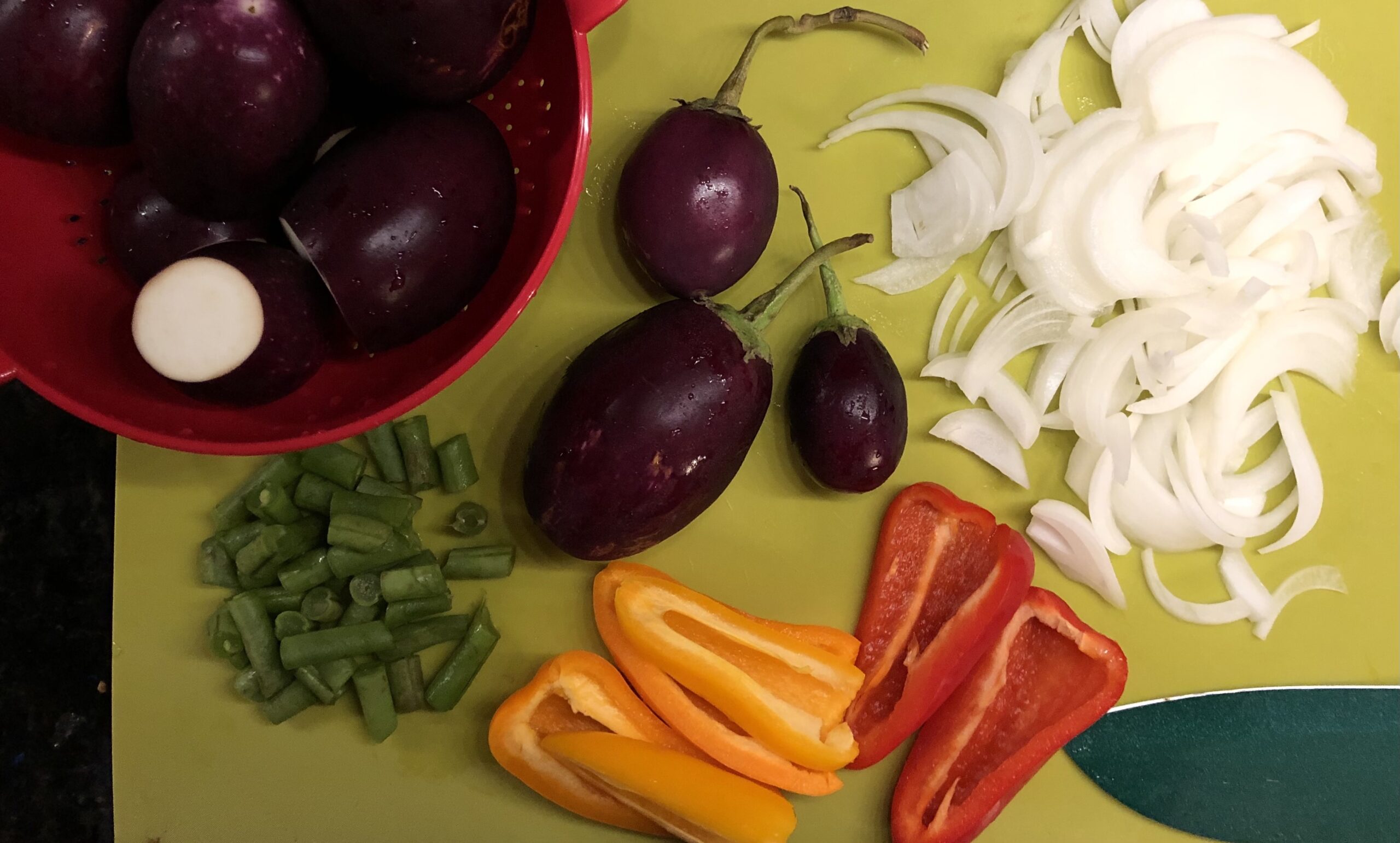
Stocking a Basic Pantry
After you have a few basics in the cookware department, you’ll need a staple shopping list and a few basic recipes. It’s also helpful to stock a basic pantry. A basic pantry includes items that you only have to buy on occasion, and those items that are shelf or freezer stable. For example, having a few spices will make what you cook so much tastier. Spices seem expensive at first, but they last a while, so you aren’t buying them regularly. Look for inexpensive brands or smaller jars.
Create a Weekly Grocery List
Next is your weekly grocery plan. This varies for everyone. For instance, a vegetarian is going to buy more canned beans, lentils, tofu, grains, rice, pasta, frozen, canned and fresh vegetables. If you’re an omnivore, you’ll still want to include those foods! Beans are versatile, nutritious, economical and easy to prepare. However, you’ll also want to include some budget-friendly meats. Meat is an excellent sources of protein, but also iron, and all meat is a good source of thiamin riboflavin, niacin, vitamin B6 and vitamin B12. Eggs are also an economical source of protein, and are one of the few foods that provide choline. Choline is important to the brain and nervous system which need it to regulate memory, mood, muscle control.
If you are considering a vegetarian or vegan diet, it’s important that you include adequate protein (like tofu, beans, nuts, or other meat alternatives) and you may need a vitamin-mineral supplement. Ask your health center if they can put you in touch with a registered dietitian to ensure your diet is well-planned and balanced.
Of course, I recommend that you include as many fruits and vegetables as you possibly can! Choose the ones you like, and the ones that are on sale. It’s often more economical to buy frozen (berries, mango) or canned (peaches, pears, applesauce). Since frozen and canned fruits and veggies are picked at the height of ripeness, then quickly processed to the freezer or can, they are just as (sometimes more) nutrient dense as fresh. They can also eliminate food waste (remember those times you bought fresh and then it rotted in the fridge?). Smoothies are also a great way to use up any that may be overripe or starting to brown.
Click here to download a pantry and shopping list.
A word about milk.
There are so many milk-type beverages on the market. If you don’t tolerate cow’s milk, you can choose soy milk. Keep in mind that other plant-based milk beverages don’t provide the protein of cow’s milk. Some have calcium added to them. It’s your choice. Just know that much of the controversy you may hear about dairy is not true. I’ve toured a lot of farms. If you have question, reach out to a dairy farmer.
Top 3 Tips to Get Cooking
- Don’t be afraid to start cooking. Even if you never had anyone teach you, there are plenty of YouTube videos and cooking shows to watch. Maybe you have a roommate who can show you a thing or two.
- It doesn’t have to be fancy or include hard to find ingredients. You’re probably on a tight budget and are short on time. Figure out what your weekly grocery allowance is, and learn how to find food bargains when you shop for groceries. If you are at the store, you’ll see the “unit price” on the white tag under the item on the shelf. If you are shopping online, you’ll also see a unit price. It may say “price per pound/ounce”. Be sure what you are comparing are equal units, then choose the least expensive option.
- Keep it simple. It’s not a cooking show contest, this is about day to day eating. Find a few simple meals that require just a few basic ingredients, and then make them each week. When you’re on a budget, it needs to be simple.
In the “Cooking For a Few or JUST U” SpotOn episode, I talked about some easy brunch and dinner options. A couple of things I didn’t get a chance to focus on: Pasta and potatoes. These inexpensive carbohydrates create an excellent platform for a nutritious and simple meal. Check out my simple meal ideas below.
Simple Meal Ideas
- Pasta is a great canvas for a simple and healthy meal. Whether it’s spaghetti, penne, ramen, egg noodles, rice noodles – it’s all affordable and so easy to cook. Top linguine with canned tuna, olive oil, frozen broccoli and some garlic. Or stir peanut butter into noodles and add frozen snap peas. Add roasted veggies and chopped, cooked chicken to penne. Try egg noodles with jarred cabbage. Of course you can enjoy the pasta with an inexpensive jarred tomato sauce too.
- I love doing a stuffed baked potato. If your’e going to turn the oven on, why not bake up a big batch and have the cooked potatoes ready. Store the leftover baked potatoes in the refrigerator for up to a week. You can do this with white or sweet potatoes, and stuff them with all sorts of things. Just bake the potato until tender and fluffy (400 degree oven for 35-45 minutes), then split it open and make it a full meal by topping it with hearty toppings! Some suggestions: leftover chili, sautéed tofu, beans, salsa and cheese, pulled pork, leftover roasted chicken and veggies. You can even eat these for breakfast or brunch. I have a stuffed breakfast sweet potato and a Tex-Mex baked potato recipe in my book.
- You can’t go wrong with an egg sandwich or breakfast burritos. You can either scramble a big batch of eggs or bake eggs in muffin cups. However, the muffin cups are great because you can use different fillings in each one and then freeze. Now. you have quick eggs ready for another day. You can add in veggies, chopped ham, tofu chunks, cheese, whatever – then use in a sandwich or burrito.
- Bagels with benefits. A plain old toasted bagel or bread gets a nutrition bump with nut butter, ricotta, sliced fruit, or seeds.
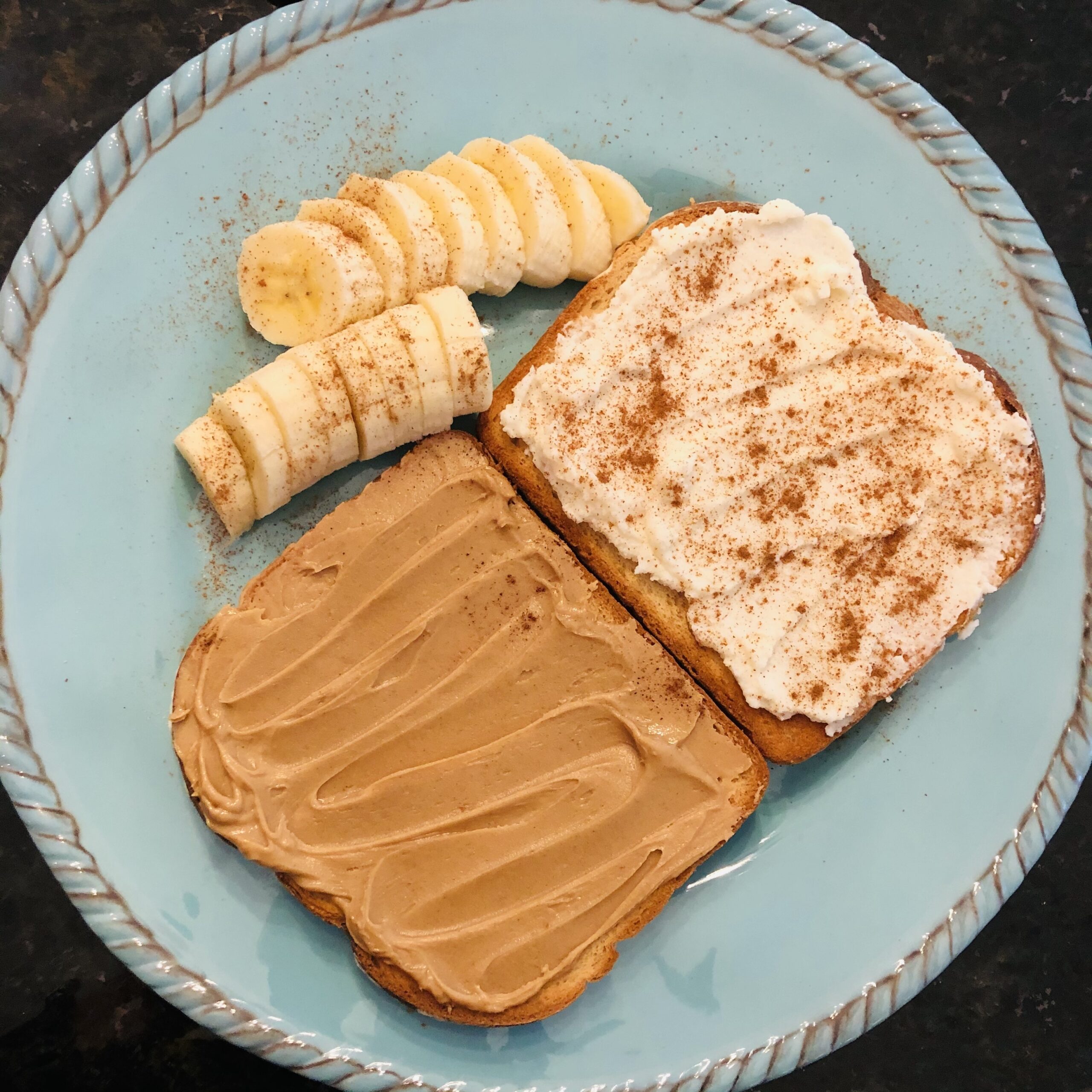
Toast with benefits – added protein from nut butter and ricotta cheese. A sprinkle of cinnamon makes it extra yummy.
- A homemade quick-bread or muffin. Muffins are so easy to make. They’re less expensive and better nutritionally than bakery muffins because you’ll use less sugar. They also freeze well. I like adding peanut butter (or powdered peanut butter or another protein powder) for added protein.
- To get your veggies in and save time, roast a big sheet pan of veggies, then use them through the week.
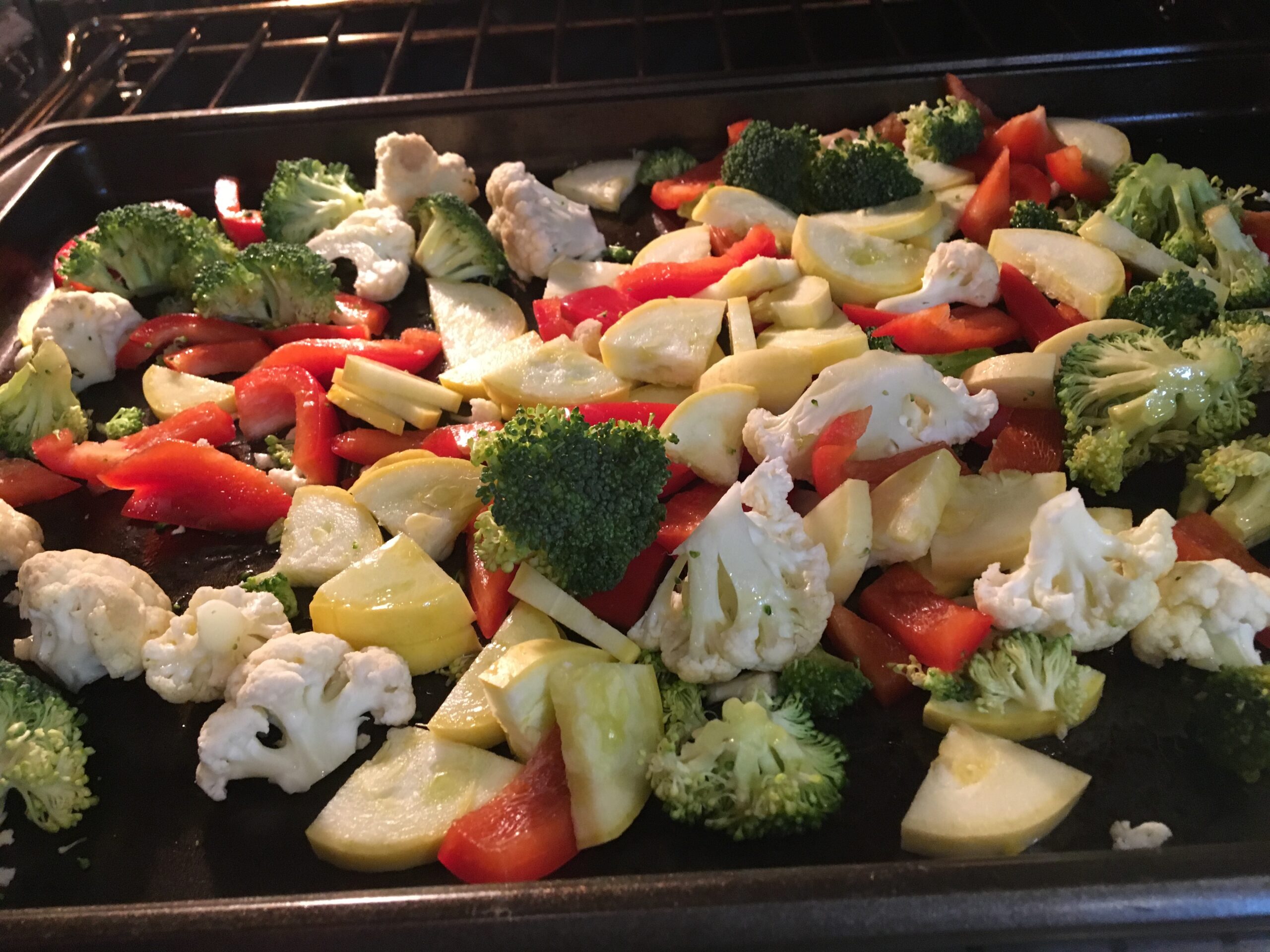
- Overnight Oats or an oatmeal bake. Combine 2 cups oats, 2 tablespoons brown sugar, 1/2 teaspoon baking powder, pinch of salt and cinnamon in a bowl. In another bowl, whisk 2 large eggs, 10 ounces of milk, 1 teaspoon vanilla extract and 2 teaspoons melted butter or vegetable oil. Stir into oat mixture. Add 1 cup of berries, and stir until blended. Spoon into an 8-inch square baking pan that was sprayed with cooking spray. Bake 35-40 minutes. Cool, cut into squares.
You’ll find recipes for sheet pan chicken with roasted veggies, stuffed potatoes and a vegged out enchilada casserole and these skillet meatballs, in DASH Diet for Two cookbook.
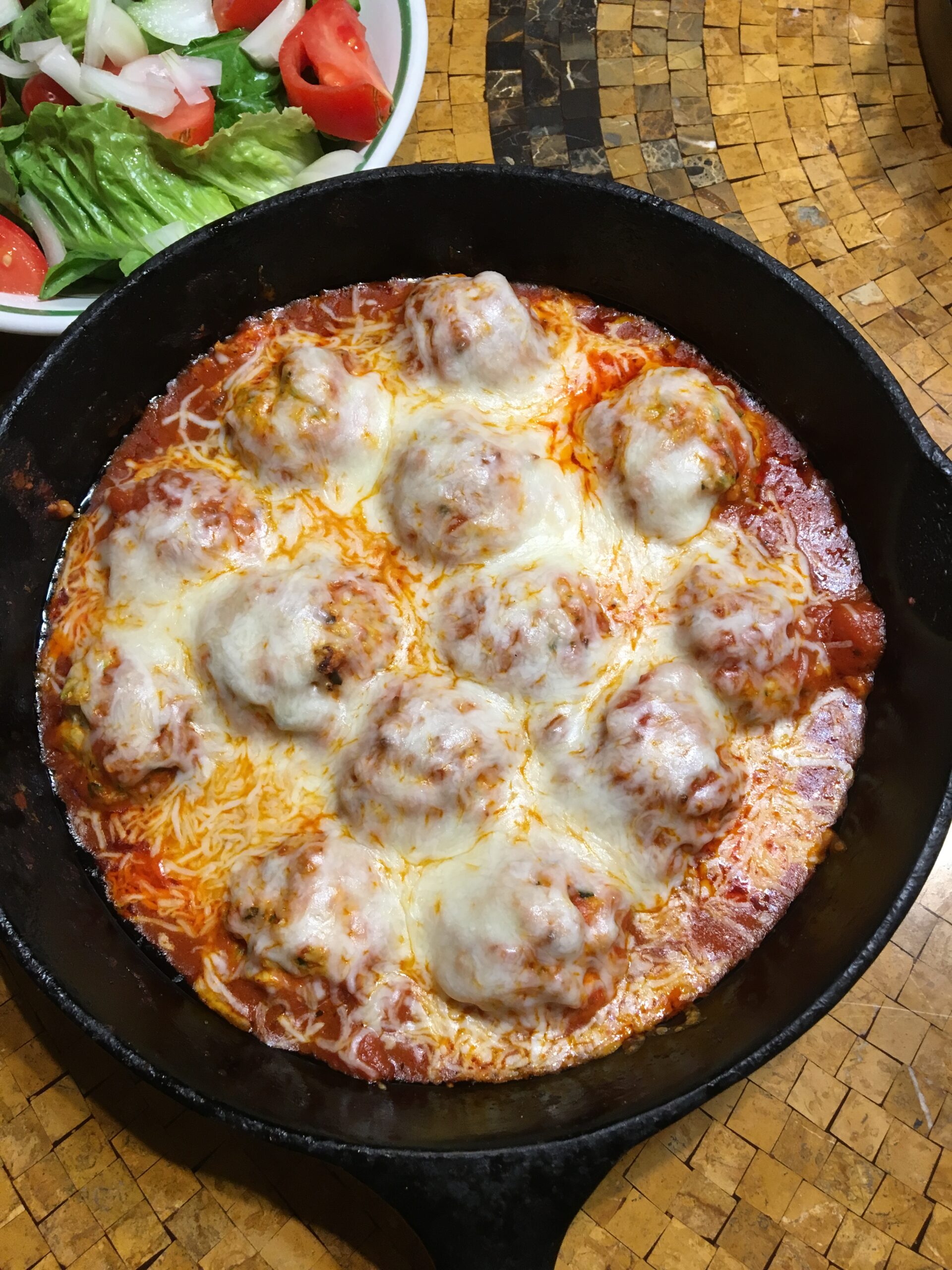
Skillet Meatballs
Ingredients
For the Meatballs
- 1 lb lean ground beef You can use a mixture of lean beef and ground turkey, or can substitute an equivalent amount of vegetarian crumbles.
- 3/4 Cup bread crumbs, plain
- 2 large eggs
- 1/4 cup milk or milk alternative
- 1 tbsp fresh parsley, minced or 1 tsp dried
- 1/8 tsp salt
- ground pepper to liking
- nonstick cooking spray
For the Sauce
- 1 tsp olive oil
- 2 garlic cloves, crushed or 2 tsp crushed garlic
- 2 14-ounce canned diced tomatoes
- 1 tsp dried oregano
- 1/2 tsp red pepper flakes optional
- 6 ounces fresh mozzarella cheese
Instructions
Cook Meatballs
- Place the beef, bread crumbs, egg, milk, parsley, salt and pepper into a large bowl
- Mix ingredients well, until completely combined.
- Divide mixture into fourths. Shape each quarter into 4 meatballs, for a total of 16 meatballs. At this point you can place into zippered freezer bags and freeze them.
- Heat a large nonstick skillet over medium high heat. Spray with cooking spray and add the meatballs. Cook for 6 to 7 minutes, turning gently so that each side browns. Reduce heat if needed. Transfer to a plate and set aside.
Create sauce and dish
- To make the sauce, add the olive oil and garlic to the same skillet. Cook over medium-low heat for 1 minute. Add the tomatoes, spices and red pepper flakes to the pan and heat for another 1 to 2 minutes.
- Transfer the meatballs back to the skillet and cook until sauce just begins to bubble. Reduce heat to low, cover, and allow to simmer for about 5 more minutes.
- Cut the fresh mozzarella into slices or small chunks. Uncover the skileet and spread the cheese evenly over the top. Replace the lid and simmer for another 2 minutes until the cheese melts.
- Serve with crusty bread and a tossed side salad.
Notes
